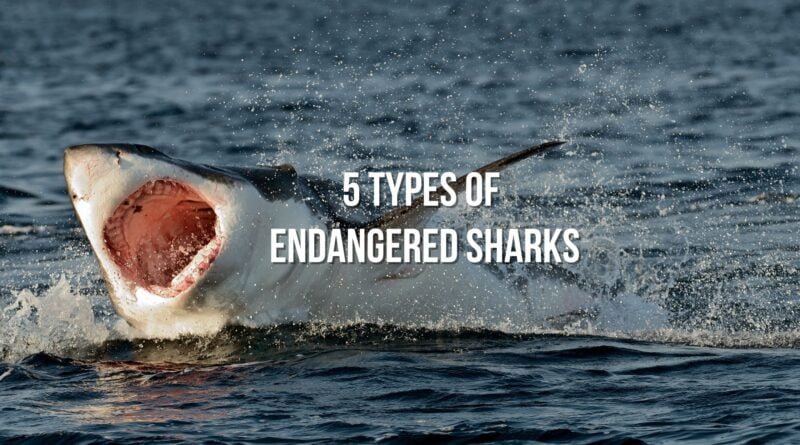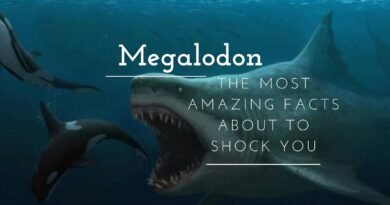5 types of endangered sharks
When we think of sharks, we often envision them as apex predators, occupying the top of the food chain. We tend to believe that they are invincible and face no threats. However, this perception couldn’t be further from the truth. Currently, even the mighty shark is not exempt from the perils of extinction. There are numerous factors contributing to this alarming situation, including shifts in ocean temperatures, illegal fishing practices, habitat destruction caused by pollution, and many others. So, are sharks endangered?
It is crucial to acknowledge the critical state of sharks, as they are among the most endangered species on our planet. Let’s now explore five types of sharks that are sadly facing the imminent threat of extinction. Sharks nets play a significant role in the conservation efforts for these threatened species.
Endangered Sharks
While most sharks are often perceived as invincible, the grim reality paints a stark contrast. These majestic creatures of the deep are some of the most vulnerable species in the world, their populations declining at a concerning rate. The causes are varied and manifold, ranging from rampant illegal fishing to pollution-induced habitat destruction.
As the situation grows increasingly dire, the term “sharks endangered” echoes as a chilling reminder of the urgency of their plight. Conservation efforts, such as the implementation of Sharks nets, have been in place to protect these threatened species. However, the success of these endeavors remains a challenge, given the scale of the threats these marine predators face.
Most importantly, we need to change our perspective towards these threatened sharks. They aren’t just the ocean’s most fearsome predators; they hold a critical role in maintaining the ecological balance of our marine ecosystems. The struggle for survival of the most sharks is not just their fight—it is ours too.
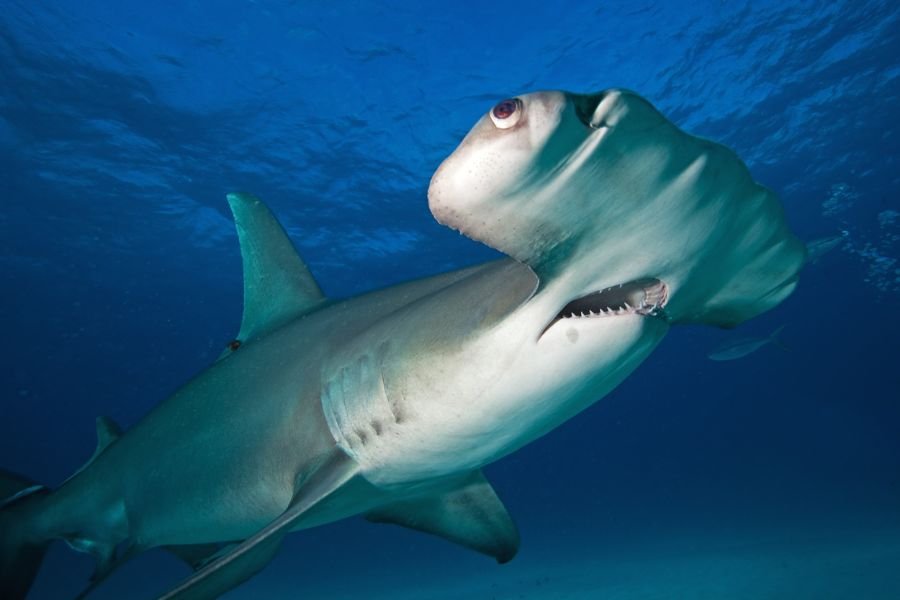
Hammerhead Shark
There are indeed great hammerhead sharks that are endangered, as well as other hammerhead species. In fact, out of the ten distinct species of hammerhead sharks, half of them are either endangered or vulnerable to extinction. This makes them part of the most endangered shark species. These amazing creatures inhabit tropical and temperate seas, primarily along coastlines and the continental shelf. They have a lifespan ranging from 20 to 30 years.
Are great hammerhead sharks endangered?
Unfortunately, hammerhead sharks face significant threats to their existence, primarily due to human activities. Unregulated fishing, both intentional and accidental, poses a great danger to their populations. Additionally, their low fertility and slow growth further exacerbate the challenges they encounter. As a result, hammerhead sharks have been included in the IUCN Red List of Endangered Species.
Habitat destruction is another concern for many shark species, including the great hammerhead sharks. To ensure the conservation of these remarkable creatures and promote healthy shark populations, it is vital to address the issues of shark fisheries and prioritize shark conservation efforts.

Great White Shark
Great white sharks, one of the largest predators in the oceans, weigh up to 3 tons. With a mouth over 3 feet wide and multiple rows of serrated teeth, they strike fear into the hearts of many. Unfortunately, these incredible creatures are now endangered. Since 2015, great white sharks have been listed as vulnerable on the IUCN Red List, joining the ranks of other endangered shark species.
These magnificent creatures can be found in both open seas and coastal areas of South Africa, North America, and South Australia. They prefer tropical and temperate waters, and can live up to 70 years. While orcas are their only natural predators, it is humans who pose the greatest threat. Our actions have led to the decline of these majestic beings.
In addition to great white sharks, other shark species, including the hammerhead species, are also facing endangerment. Among them, the great hammerhead shark stands out as one of the most endangered shark species. It is important that we take action to protect these incredible creatures before it’s too late. By raising awareness and implementing conservation efforts, we can make a difference for the future of sharks and the many species that depend on healthy ocean ecosystems.
Are Great White Sharks Endangered?
The great white shark’s extinction would have an unprecedented impact on the ecosystem. Since it is at the top of the marine food chain: seals, octopuses, turtles, dolphins, and sea lions are part of its diet. Without this greater natural predator, there would be a lack of population control of these animals. Therefore would increase the consumption of fish. This lack of control would affect the planktonic algae, most responsible for the oxygen production on the planet. Can you imagine how massive this damage could be?
The causes of the great white shark’s danger are almost the same as the hammerhead shark: low fecundity (only 2 pups at a time) and slow growth associated with predatory, competition, or commercial fishing.
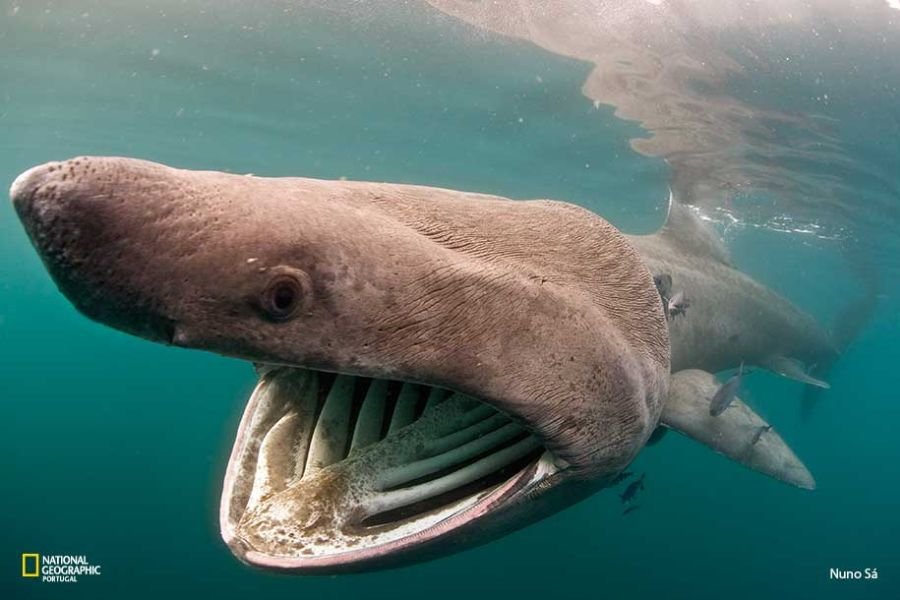
Basking shark
The basking shark, also known as the elephant shark, is renowned as one of the largest and most majestic creatures in the ocean. This incredible shark, measuring over 26 feet in length and weighing more than 5 tons, ranks as the second largest fish globally, surpassed only by the whale shark. Its presence is felt across oceans worldwide, particularly in subpolar and temperate seas, making it an important migratory species. Despite its formidable appearance, the basking shark is a gentle giant, peacefully consuming plankton as its primary food source. However, this magnificent species faces numerous challenges that place it at risk of endangerment.
Among the factors contributing to the vulnerability of basking sharks is their susceptibility to fishing activities. As planktonic organisms float passively in the water, the basking shark must come to the surface for extended periods to feed, making it an easy target for fishermen. Additionally, historical demand for the shark’s liver oil, used as fuel and for medicinal purposes, has had a detrimental impact on its population.
Are Basking Sharks Endangered?
Presently, basking sharks are classified as critically endangered, highlighting their precarious conservation status. The decline in shark populations, particularly the most endangered shark species, is a cause for concern within the marine ecosystem. The reduction in available biomass, due to pollution and other human-induced factors, poses a significant risk to the survival of many species of sharks and rays.
Efforts to protect and conserve basking sharks, as well as other endangered sharks, are crucial to maintaining the balance of the marine ecosystem. It is imperative that we raise awareness about the conservation needs of these majestic creatures and work towards sustainable fishing practices and the preservation of their habitats. Together, we can ensure the long-term survival and well-being of these remarkable creatures and safeguard the health of our oceans for future generations.

Sailfin roughshark
The sailfin roughshark, also known as the pig-like shark, is one of the most endangered shark species. These unique sharks, with their flat, pink noses and wide-set eyes, are relatively small, reaching lengths of up to 3 feet. They possess spiny dorsal fins and inhabit the Atlantic Ocean, ranging from Europe to Norway and South Africa. Sadly, their conservation status is critically endangered, reflecting the negative impact of human activities on shark populations.
Conservation Status
The sailfin roughshark’s vulnerability to accidental fishing is a consequence of its habitat overlap with areas of high fishing activity. This highlights the urgent need for conservation efforts to protect not only this species but also many other shark and ray species in our marine ecosystem. The decline of these migratory species poses a threat to the balance and health of the entire marine ecosystem. Therefore, it is crucial to raise awareness and take action to safeguard these valuable and ecologically significant creatures.
By focusing on the conservation status of endangered sharks like the sailfin roughshark, we can work towards preserving the diversity and resilience of our oceans for future generations.
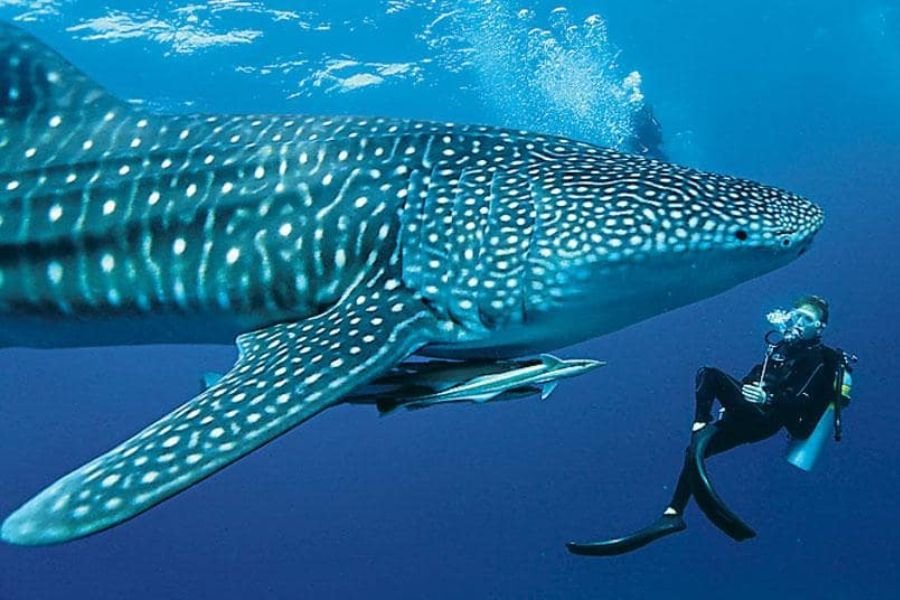
Whale shark
Just like the basking shark, the whale shark is also a filter-feeding animal that primarily consumes plankton and small fish. This makes them harmless giants, not posing any threat to humans. However, the opposite cannot be said, unfortunately. The whale shark, considered the largest fish in the seas, is not a cetacean but a fish. It can grow up to an impressive length of 52 feet and weigh as much as 20 tons. Its average lifespan in the wild is around 70 years, but it can potentially live even longer.
Whale sharks are known for their docile nature, and it is not uncommon for divers to swim alongside them, and some even hitch a ride on their massive bodies. They inhabit warm to moderate tropical ocean waters, typically found at depths of around 660 feet. Similar to the basking shark, these gentle giants need to be close to the surface to feed on plankton, which puts them at risk. The navigation of large marine vessels, such as oil tankers, poses a significant threat to whale sharks, as collisions with these ships can result in severe injuries and death.
Are Whale Sharks Endangered?
Unfortunately, whale sharks are classified as an endangered species. In recent years, their population has significantly decreased, primarily due to these collisions with marine transport vehicles. This decline is a cause for concern, as whale sharks play a crucial role in marine ecosystems. Being one of the most endangered shark species, their preservation is crucial for maintaining the balance of our oceans and the diversity of shark and ray species.
Efforts are being made to protect and conserve whale sharks, as they are recognized as a critically endangered species. Conservation measures aim to address the various threats they face, including ship strikes and habitat degradation. By raising awareness about the importance of these magnificent creatures and implementing sustainable practices, we can contribute to the preservation of whale sharks and the overall health of our marine ecosystems, ensuring the survival of not just whale sharks, but many other species of sharks and rays as well.
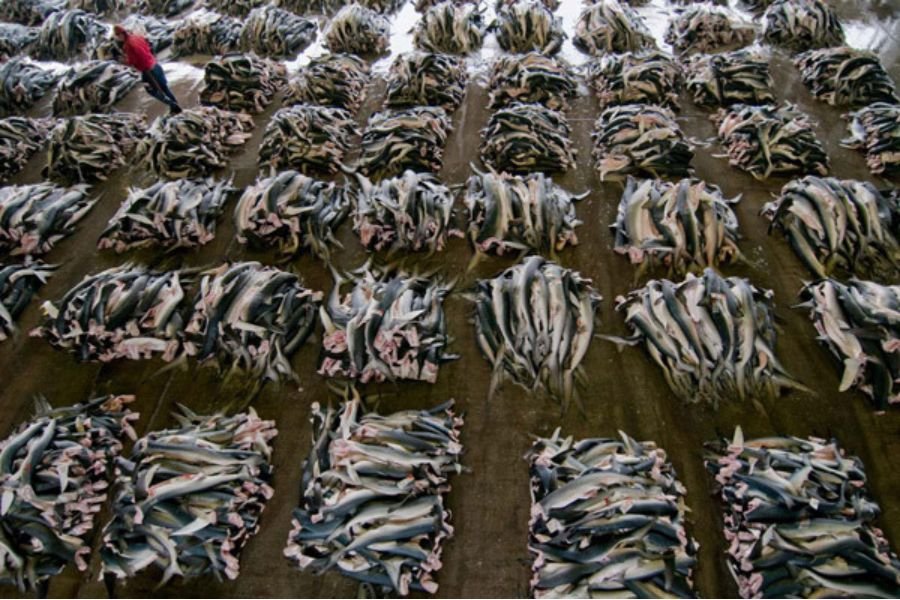
Causes for the danger of extinction of shark species
Fin Fishing
Throughout the reading, it is evident that anthropic actions are the main causes of vulnerability among shark species, resulting in severe environmental impacts. One of the most cruel practices is shark finning, where fishermen capture sharks, cut off their fins, and discard them back into the sea while they are still alive, causing slow and agonizing deaths.
The brutality involved in this form of “fishing” can be likened to the killing of elephants for ivory and rhinos for their horns, all driven by human greed. Similar to elephants and rhinos, sharks cannot regenerate their fins once they are removed, leading to their demise. It is important to note that this market of unsustainable production cannot be justified.
The shark fin trade and shark finning have significantly contributed to the decline of shark populations, making them an vulnerable species. Conservation efforts must be intensified to protect these magnificent creatures from further harm caused by shark fisheries.

Shark Fin Soup
Shark fins are very ‘appreciated’ in oriental cuisine: a dish of shark fin soup can cost up to 100 dollars. It has become a symbol of social status, served in restaurants frequented by the world society elite (it is not just Asian countries that serve this dish).
The worst part of it is that they say it doesn’t even have a flavor. The fin has no taste at all and it all depends on the seasonings and spices that it is put in the recipe.

“Cação” is a shark – Brazil
In addition to the alarming issue of fin soup, shark meat is highly sought after, with Brazil being the largest importer in the world. When visiting Brazil, you might come across fish meat labeled as “postas de Cação” in supermarkets and fish markets. However, what many people don’t realize is that “cação” is actually a Portuguese term for shark, and any species of shark or even ray can be sold under this generic name without informing consumers. This lack of transparency poses a threat to the health of individuals, as shark and ray meat can be harmful due to the accumulation of contaminants such as pesticides, metals, and petroleum derivatives.
These pollutants are absorbed by sharks and rays throughout their lives, as they occupy a high position in the food chain. It’s important to raise awareness about the impact of consuming threatened sharks, which are among the most vulnerable species. Organizations like Sea Shepherd Brasil have launched the “Cação é Tubarão” campaign to shed light on this issue. Additionally, the use of shark nets has also contributed to the decline of these magnificent creatures. Protecting sharks is crucial for the preservation of our oceans and the delicate balance of marine ecosystems.

Shark meat – United States and Europe
In the United States, shark meat is consumed to some extent, although it is not widely recognized as a delicacy. Similar to the situation in Brazil, a significant number of people who consume shark meat are likely unaware of the species they are actually consuming.
Names like dogfish, flake, whitefish, and grayfish are used to disguise or mislead buyers. It is worth noting that dishes like Fish and Chips and Surimi (imitation crab) often contain shark meat, without proper disclosure during sale.
Furthermore, it is important to highlight that the sale and consumption of shark meat are not illegal in the USA and Europe. However, the cruel practice of finning, where the fins are removed while the shark is alive and then left to die slowly in the sea, is considered a crime.
Sharks are endangered, with many species being threatened or classified as the most endangered. The IUCN Shark Specialist Group focuses on the conservation of oceanic sharks, recognizing the urgent need to protect these magnificent creatures.
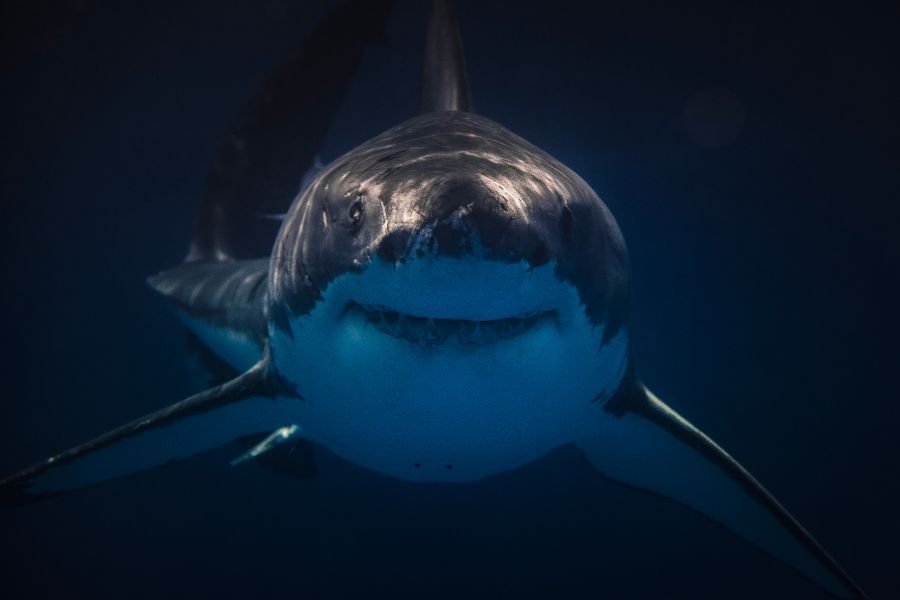
Conclusion
It wasn’t just an easy read, nor was it a pleasant one, was it? We sincerely apologize for that. As we always emphasize, it is crucial to understand and address the challenges faced by nature, especially when it comes to the plight of endangered sharks. So, what can we do to make a difference? The answer is clear: we can start by refraining from purchasing dogfish meat, which is, in fact, shark meat. By spreading awareness among our friends and acquaintances about the vulnerability of sharks, we can help protect these magnificent creatures.
Furthermore, it is essential to educate others about the vital role sharks play in maintaining the balance of our environment. There is no reason to fear them. To put things into perspective, did you know that between 2001 and 2013, more people lost their lives due to dog attacks than shark attacks? The numbers are staggering: 364 fatalities from dog attacks compared to only 11 from shark attacks during the same period, as reported by the Florida Natural History Museum.
While we may not be able to single-handedly change the world, we can certainly make a concerted effort. Let’s continue to stay informed and connected. Together, we can support the conservation of sharks, one of the most vulnerable species on our planet. Let’s also address the issue of threatened sharks, the importance of shark nets, and the protection of these remarkable creatures. Thank you for your continued support, and we look forward to connecting with you again soon!

